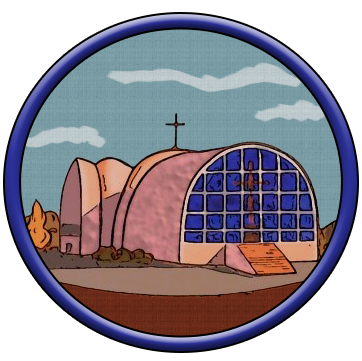Rites of Initiation
In accordance with the practice of the Ancient Church, Baptism, Chrismation and Holy Eucharist are celebrated as a single rite.
The Rite of Baptism:
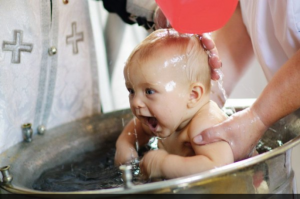 Baptism is a mystery which cleanses us from original sin and gives our souls the new life of sanctifying grace by which we become children of God and heirs of heaven. Baptism is one of the three rites of initiation into the Church. Through baptism the believer partakes in the Death and Resurrection of Christ. Baptism of water is necessary for the salvation of all men because Christ has said: ‘Unless a man be born again of water and the Holy Ghost, he cannot enter into the kingdom of God’ (John 3:5).
Baptism is a mystery which cleanses us from original sin and gives our souls the new life of sanctifying grace by which we become children of God and heirs of heaven. Baptism is one of the three rites of initiation into the Church. Through baptism the believer partakes in the Death and Resurrection of Christ. Baptism of water is necessary for the salvation of all men because Christ has said: ‘Unless a man be born again of water and the Holy Ghost, he cannot enter into the kingdom of God’ (John 3:5).
The custom now is to baptize infants. Baptizing infants before they know what is going on is an expression of God’s great love for us. It shows that God loves us and accepts us before we can ever know Him or love Him. It shows that we are wanted and loved by God from the very moment of our birth. To say that a person must reach the age of reason and believe in Christ before he may be baptized is to make God’s grace in some way dependent on man’s intelligence. But God’s grace is not dependent on any act of ours, intellectual or otherwise; it is a pure gift of His love.
The Rite of Chrismation:
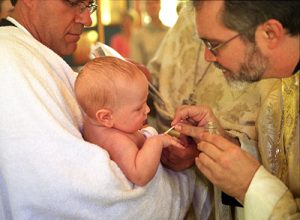
Image courtesy of the Antiochian Orthodox Archdiocese of North America
The second rite of initiation into the Church is Chrismation, which is considered the believer’s personal moment of Pentecost; through an anointing with oil, the priest seals the person with the “gift of the Holy Spirit”.
The Mystery of Holy Communion (Eucharist):
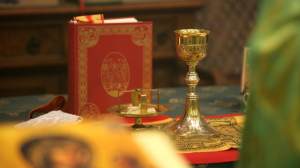
The third rite of initiation is the reception of the Holy Eucharist. Immediately following baptism, the neophyte may receive the precious Body and Blood of Christ in the Sacrament of Holy Communion and, in the case of an infant, is brought to Church regularly after baptism to receive the sacrament. The new life in Christ, given in baptism, is renewed again and again in the Eucharist. Every baptized and confirmed infant becomes a full member of the Church and is entitled to receive Holy Communion. As nature provides milk for the nourishment of the infant after birth, so God provides Holy Communion for the infant immediately following baptism in order to provide nourishment for the spiritual life the neophyte has received through baptism.
Elements of Eastern Initiation Rite
Inscription– the name is entered into the Book of Life
Exorcism- the first act of the baptismal service begins in the narthex (entrance) of the church. This is to show that the one being received is not yet a member of the Church. The purpose of baptism is to bring him into the Church; to enter into the temple of God is to be with Christ, to become a member of His body.
The priest then calls upon the sponsors to renounce the devil and all his works for the child: “Do you renounce Satan, and all his angels, and all his works, and all his services, and all his pride?” Father Alexander Schmemann explains the meaning of this renunciation when he says,” The first act of the Christian life is a renunciation, a challenge. No one can be Christ’s until he has, first faced Evil, and then become ready to fight it. The exorcisms mean this: to face Evil, to acknowledge its reality, to know its power, and to proclaim the power of God to destroy it. The exorcisms announce the forthcoming baptism as an act of victory.”
The renunciation of Satan is done facing the west because the west is where the sun disappears and was regarded by the ancient Greeks as the place of the gates of Hades.
Then the priest faces east whence the light of the sun rises and asks the godparents to accept for the child Him who is the Light of the World, “Do you unite yourself to Christ?” The renunciation of Satan and the union with Christ express our faith that the newly-baptized child has been transferred from one master to another, from Satan to Christ.
The Profession of Faith-The godparents are then asked to confess faith in Christ in behalf of the infant. They read the confession of faith contained in the Nicene Creed as they walk in procession to the front of the church.
Pre-Baptismal Anointing– Olive oil is blessed and then applied by the priest to the various members of the child’s body: hands, feet, ears, mouth, in order to dedicate them to the service of Christ.
Baptism: is given by pouring water on the head of the person to be baptized. In our rite the priest takes the role of mediator in the ceremony, calling upon God to baptize the child. When pouring the water, he says “The servant of God is baptized . . .” In the Western Church, the priest says, “I baptize you . . .”
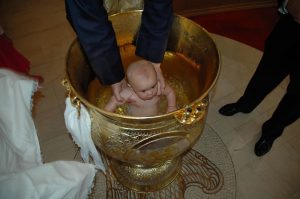
Picture courtesy of blessedcelebrations.com
Note: Traditionally the baptism is through complete immersion of the infant. The immersion in water symbolizes death, since a person cannot live long under water. Through baptism we share mysteriously in Christ’s death. The baptized person risesout of the baptismal font a new person, cleansed of every sin. The triple immersion symbolizes the three days our Lord spent in the tomb as well as the Holy Trinity.
Baptism by immersion in warm, oily water gives the catechumen a feeling of being entirely enveloped by the Holy Spirit.
New White Garment (or a white cloth) – The new clothes signify the entirely new life that we receive after we are “buried with Jesus in his death” (Rom. 6:4). The white robe expresses the purity of the soul that has been washed from sin.
A candle is lit and a prayer is said that the newly baptized will “shine brightly with the light of faith and of good works.” Baptism remains the sacrament of entrance into light. It opens the eyes of the soul to see Christ, the light of the world (John 1: 19).
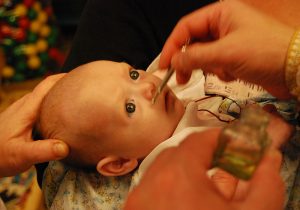 Rite of Chrismation: The Mystery of Confirmation is administered immediately following baptism as in the early Church. It is considered the fulfillment of baptism. Human nature purified by baptism is made ready to receive the manifold gifts of the Holy Spirit. The whole person is now made the temple of God. The priest anoints the baptized child with holy Chrism, making the sign of the Cross upon the forehead, the eyes, the nostrils, the lips, the ears, the breast, the hands, and the feet while intoning “The seal of the Gift of the Holy Spirit.”
Rite of Chrismation: The Mystery of Confirmation is administered immediately following baptism as in the early Church. It is considered the fulfillment of baptism. Human nature purified by baptism is made ready to receive the manifold gifts of the Holy Spirit. The whole person is now made the temple of God. The priest anoints the baptized child with holy Chrism, making the sign of the Cross upon the forehead, the eyes, the nostrils, the lips, the ears, the breast, the hands, and the feet while intoning “The seal of the Gift of the Holy Spirit.”
Reading of the Epistle: (Romans 6:3-11)
Reading of the Gospel: (Matthew 28:16-20)
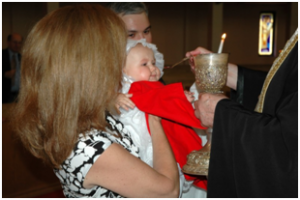
Picture courtesy of blessedcelebrations.com
Eucharist: Immediately following baptism the neophyte may receive the precious Body and Blood of Christ in the Sacrament of Holy Communion. The child may continue to receive the Eucharist until ready for his/her FIRST SOLEMN HOLY COMMUNION.
In early times Baptism and Confirmation were not administered in the church but in a separate building called the baptistery. Following anointment with holy chrism the newly baptized, wearing their white robes and carrying candles, were led by the clergy to the church for the celebration of the Eucharist. Here they would receive their first Communion.
This is the origin of the present procession of the priest accompanied by the sponsor holding the newly baptized infant. The purpose of Baptism and Chrismation is expressed by this procession to the Eucharist. The door is now open to full and complete communion with God.
Churching of the Child–On the fortieth day after Jesus’ birth Mary brought him into the temple where Simeon took him into his arms. The priest now takes the newly baptized infant and prays:
- “The servant of God is churched in the name of the Father and the Son and the Holy Spirit.” Then before the icons of Jesus and Mary:
- “The servant of God enters into the house of God; may he/she adore the Son of the Blessed Virgin Mary”
- “The servant of God has entered the house of God. Within the church he/she shall praise you.”
This service ends with the singing of the traditional “Mnohaya Lita” (“God Grant Them Many Years”), a prayer requesting peace, health and prosperity for many years to come!
For a more comprehensive explanation see:
The Catechism of the Ukrainian Catholic Church: Christ Our Pascha pg 140-153.
luminousdarkcloud.baptism-being-born-again-of-water-and-the-spirit
